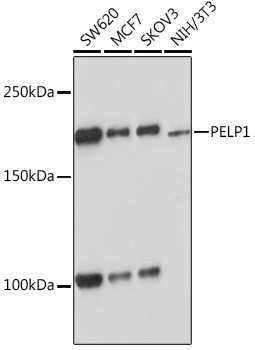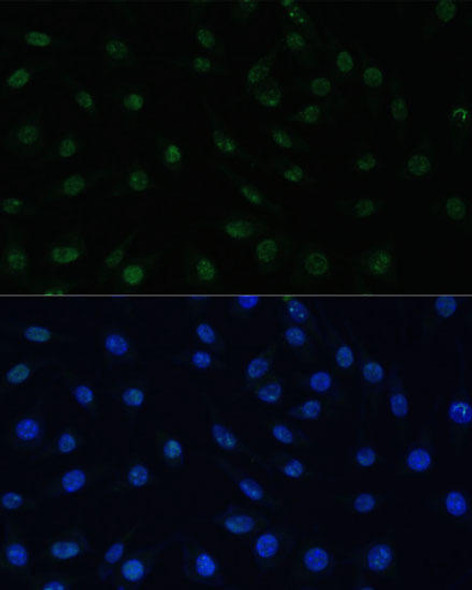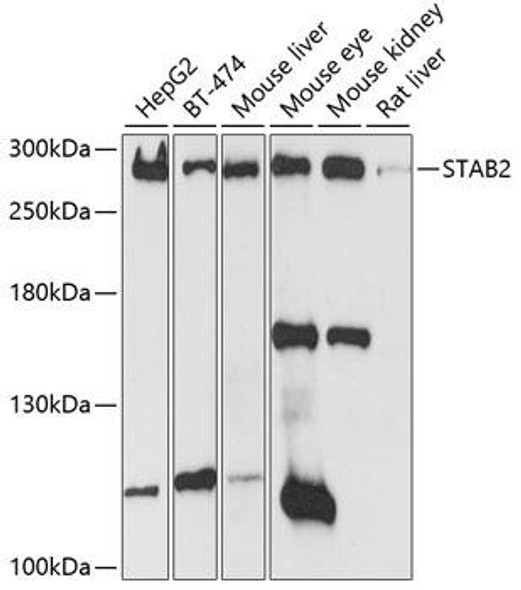Anti-PELP1 Antibody (CAB9026)
- SKU:
- CAB9026
- Product type:
- Antibody
- Reactivity:
- Human
- Mouse
- Rat
- Host Species:
- Rabbit
- Isotype:
- IgG
- Antibody Type:
- Monoclonal Antibody
- Research Area:
- Epigenetics and Nuclear Signaling
Frequently bought together:
Description
| Antibody Name: | Anti-PELP1 Antibody |
| Antibody SKU: | CAB9026 |
| Antibody Size: | 20uL, 50uL, 100uL |
| Application: | WB |
| Reactivity: | Human, Mouse, Rat |
| Host Species: | Rabbit |
| Immunogen: | A synthesized peptide derived from human PELP1 |
| Application: | WB |
| Recommended Dilution: | WB 1:500 - 1:2000 |
| Reactivity: | Human, Mouse, Rat |
| Positive Samples: | SW620, MCF7, SKOV3, NIH/3T3, Rat testis |
| Immunogen: | A synthesized peptide derived from human PELP1 |
| Purification Method: | Affinity purification |
| Storage Buffer: | Store at -20°C. Avoid freeze / thaw cycles. Buffer: PBS with 0.02% sodium azide, 0.05% BSA, 50% glycerol, pH7.3. |
| Isotype: | IgG |
| Sequence: | Email for sequence |
| Gene ID: | 27043 |
| Uniprot: | Q8IZL8 |
| Cellular Location: | |
| Calculated MW: | 120kDa |
| Observed MW: | 160KDa |
| Synonyms: | MNAR, P160 |
| Background: | This gene encodes a transcription factor which coactivates transcription of estrogen receptor responsive genes and corepresses genes activated by other hormone receptors or sequence-specific transcription factors. Expression of this gene is regulated by both members of the estrogen receptor family. This gene may be involved in the progression of several types of cancer. Alternative splicing results in multiple transcript variants. [provided by RefSeq, May 2013] |
| UniProt Protein Function: | PELP1: Coactivator of estrogen receptor-mediated transcription and a corepressor of other nuclear hormone receptors and sequence- specific transcription factors. Plays a role in estrogen receptor (ER) genomic activity when present in the nuclear compartment by activating the ER target genes in a hormonal stimulation dependent manner. Can facilitate ER non-genomic signaling via SRC and PI3K interaction in the cytosol. Plays a role in E2-mediated cell cycle progression by interacting with RB1. May have important functional implications in ER/growth factor cross-talk. Interacts with several growth factor signaling components including EGFR and HRS. Involved in nuclear receptor signaling via its interaction with AR and NR3C1. May promote tumorigenesis via its interaction with and modulation of several oncogenes including SRC, PI3K, STAT3 and EGFR. Plays a role in cancer cell metastasis via its ability to modulate E2-mediated cytoskeleton changes and cell migration via its interaction with SRC and PI3K. Interacts with HRS, RXRA, SUMO2, HDAC2, RB1 and STAT3. Interacts with PI3K, SRC and EGFR in cytoplasm. Interacts with ESR1 and ESR2 and this interaction is enhanced by 17-beta- estradiol. Interacts with CREBBP, EP300, AR and NR3C1 in a ligand- dependent manner. Forms two complexes in the presence of 17-beta- estradiol; one with SRC and ESR1 and another with LCK and ESR1. Interacts with histone H1 and H3 with a greater affinity for H1. Component of some MLL1/MLL complex, at least composed of the core components MLL, ASH2L, HCFC1/HCF1, WDR5 and RBBP5, as well as the facultative components C17orf49, CHD8, E2F6, HSP70, INO80C, KANSL1, LAS1L, MAX, MCRS1, MGA, KAT8/MOF, PELP1, PHF20, PRP31, RING2, RUVB1/TIP49A, RUVB2/TIP49B, SENP3, TAF1, TAF4, TAF6, TAF7, TAF9 and TEX10. Isoform 2 is expressed in breast cancer cell lines. Isoform 1 is widely expressed. 2 isoforms of the human protein are produced by alternative splicing. |
| UniProt Protein Details: | Protein type:Nuclear receptor co-regulator; Transcription, coactivator/corepressor Chromosomal Location of Human Ortholog: 17p13.2 Cellular Component: nucleoplasm; membrane; cytoplasm; nucleolus; nucleus Molecular Function:protein binding; chromatin binding; transcription factor binding Biological Process: transcription, DNA-dependent; positive regulation of transcription from RNA polymerase II promoter |
| NCBI Summary: | This gene encodes a transcription factor which coactivates transcription of estrogen receptor responsive genes and corepresses genes activated by other hormone receptors or sequence-specific transcription factors. Expression of this gene is regulated by both members of the estrogen receptor family. This gene may be involved in the progression of several types of cancer. Alternative splicing results in multiple transcript variants. [provided by RefSeq, May 2013] |
| UniProt Code: | Q8IZL8 |
| NCBI GenInfo Identifier: | 115502553 |
| NCBI Gene ID: | 27043 |
| NCBI Accession: | Q8IZL8.2 |
| UniProt Secondary Accession: | Q8IZL8,O15450, Q5EGN3, Q6NTE6, Q96FT1, Q9BU60, |
| UniProt Related Accession: | Q8IZL8 |
| Molecular Weight: | 1130 |
| NCBI Full Name: | Proline-, glutamic acid- and leucine-rich protein 1 |
| NCBI Synonym Full Names: | proline, glutamate and leucine rich protein 1 |
| NCBI Official Symbol: | PELP1 |
| NCBI Official Synonym Symbols: | MNAR; P160 |
| NCBI Protein Information: | proline-, glutamic acid- and leucine-rich protein 1; transcription factor HMX3; proline and glutamic acid rich nuclear protein; modulator of non-genomic activity of estrogen receptor |
| UniProt Protein Name: | Proline-, glutamic acid- and leucine-rich protein 1 |
| UniProt Synonym Protein Names: | Modulator of non-genomic activity of estrogen receptor; Transcription factor HMX3 |
| Protein Family: | Proline-, glutamic acid- and leucine-rich protein |
| UniProt Gene Name: | PELP1 |
| UniProt Entry Name: | PELP1_HUMAN |










